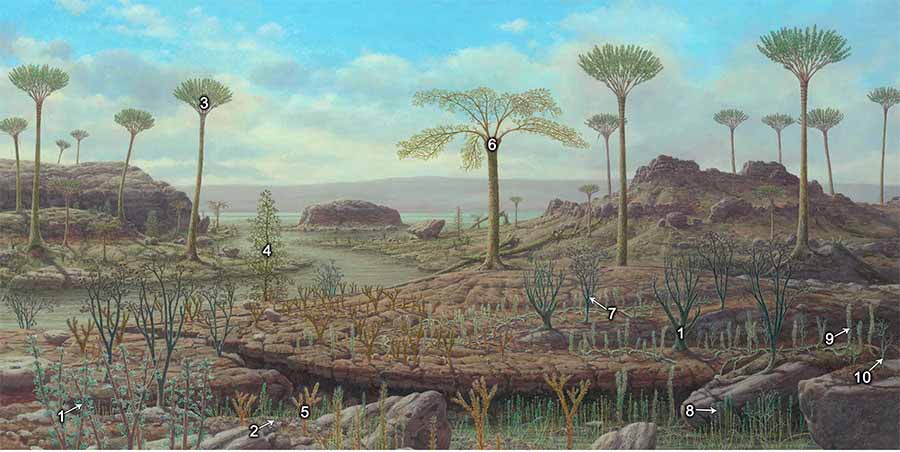Devonian Park sounds like a lovely place to take a stroll? Well not exactly. Join us on a voyage through hundreds of millions of years and to the ocean that spanned across France.
Today, the peloton will ride through the hilly landscape of the eastern side of the Massif Central. The meadows and pastures of this 12th stage hide the remains of the volcanoes and oceans that were active in this area during the Devonian period, about 400 million years ago. Somewhere along the hills, the cyclists will pass through the metamorphosed rocks of the Morvan volcanic islands. They will encounter pieces of ocean floor and even the mantle that were emplaced over the continents during the formation of Pangea, 320 million years ago.
World of plants
During the Devonian, the landscape of the Massif Central looked quite different from what it is today or what it was like during the formation of Pangea. Imagine an ocean between two large landmasses that were getting closer and closer, much like the Mediterranean today. Gondwana to the south (South America + Africa + Australia) and Laurussia (North America and the Baltic countries) to the north sandwiched the Rheic ocean. This ocean was, just like the Mediterranean, full of volcanic islands, beaches, and small oceanic basins (like the Tyrrhenian).

This landscape had no olive trees nor seagulls. Welcome to Devonian Park. All vegetation you could see were ferns and horsetails, and walking animals were scorpions, insects, mites, and myriapods. If you were lucky, you might have seen a four-legged fish trying to get out of the water. It is a distant cousin of all amphibians, reptiles, and mammals. But do not get into the water!
The age of fishes
The ‘Age of Fishes’, as geologists call the Devonian, was much like the Mesozoic. That period was called the ‘Age of Dinosaurs’. In both eras just walking around was an adventure sport. Trying to get some refreshment in the waters of the Rheic Ocean was scary. Fish like Dunkleosteous, the size of a large tuna, with jaws larger than a human head and an armored head like a tank, were the terror of the Devonian oceans. Today along the stage we can see some relics of these daring paradise. There are some granitic rocks of the magmatic chambers of the volcanoes and the sedimentary rocks that formed after the erosion of such volcanic islands.

Devonian at your own risk
The seas and beaches of the Rheic Ocean were not just daunting to us. Living in the Devonian world was a risky activity. Nothing idyllic about Devonian Park because over a period of 50 million years, the Devonian witnessed two mass extinctions that wiped out 70% of all species. The general extinction rate was higher than it is today. Consider that the latest mass extinction (when the dinosaurs disappeared) happened 66 million years ago. The one before that was 200 million years ago.

The most remarkable issue is that evolution of life on dry land had just begun. A new ecological niche was available for all to exploit. Despite this opportunity, life struggled. The reasons for this are unclear. Some suggest that the development of land plants contributed to global cooling. Remember that climate change is quite dangerous! Others argue that the Devonian was plagued by too many active volcanoes, such as the one that the race is crossing today. These volcanoes altered the chemical conditions of the water, making life close to impossible.
Getting lost
But okay, perhaps living on one of the Rheic islands in this hostile Devonian world is not the best idea. Maybe it’s time to leave? Let’s say you wanted to head southwest to the hinterlands of Gondwana. You take your compass to ensure that you take the right path, but the needle is numb. You hit the compass. It’s not a great idea to hit scientific instruments, but you think it might be stuck. The needle moves, but it doesn’t point to the north or anywhere else. It won’t do so for millions of years.

During the Devonian, the Earth’s magnetic field almost switched off. The magnetic field of the past generally gets recorded in volcanic rocks that contain a lot of magnetite. This is a mineral which, when cooled down from lavas, aligns with the Earth’s magnetic field.
We have no idea why the magnetic field was so weak. No matter how hard we try, most of the Devonian volcanic rocks, such as the ones in today’s stage, did not record any magnetic field. The very few that did record it have an incredibly weak signal. Luckily for riders and geologists, our magnetic field is strong. Our compasses work and the parcours doesn’t cross an ocean infested with terrifying Devonian creatures. We could almost imagine it to be the peaceful Devonian Park we all wanted.
Douwe and Marjolein went on a little walk through Devonian times.





